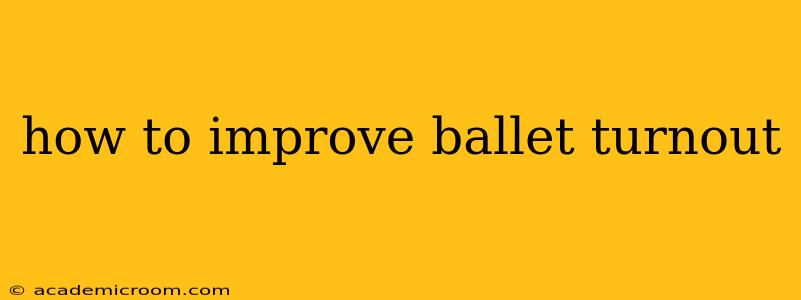Ballet turnout, the outward rotation of the legs from the hips, is a cornerstone of classical ballet technique. Achieving a deep, safe, and aesthetically pleasing turnout takes dedication, proper training, and a deep understanding of your body's mechanics. This guide will delve into effective strategies to improve your turnout, addressing common questions and misconceptions.
What Muscles Are Involved in Turnout?
Achieving optimal turnout isn't solely about the muscles in your legs; it's a coordinated effort involving several muscle groups throughout your body. The primary muscles contributing to turnout are the external rotators of the hip, including the piriformis, obturator internus and externus, quadratus femoris, and gemelli muscles. However, strength and flexibility in your gluteus medius and minimus, as well as your inner thighs (adductors), are crucial for supporting and stabilizing the turnout. Core strength is also essential for maintaining proper alignment and preventing injury.
How Can I Improve My Turnout Safely?
Improving your turnout requires a patient and persistent approach, prioritizing safety over speed. Avoid forcing your turnout; this can lead to serious injuries like hip impingement or labral tears. Instead, focus on these strategies:
1. Warm-up Thoroughly:
Before attempting any turnout exercises, a thorough warm-up is crucial. This should include dynamic stretches like leg swings, hip circles, and torso twists to prepare your muscles for the work ahead.
2. Targeted Strength Training:
Incorporate exercises specifically designed to strengthen the external rotators and supporting muscles. These include:
- Clamshells: Lie on your side with knees bent, keeping your feet together. Lift your top knee, maintaining contact between your feet.
- External Rotation with Resistance Band: Sit with a resistance band around your thighs, just above your knees. Externally rotate your legs against the resistance.
- Glute Bridges: Lie on your back with knees bent and feet flat on the floor. Lift your hips off the floor, squeezing your glutes at the top.
- Single Leg Glute Bridges: Similar to glute bridges but performed with one leg extended in the air. This helps improve glute strength for better hip stability.
3. Flexibility Work:
Improving flexibility in the hips and surrounding muscles is essential for achieving a greater range of motion. Incorporate stretches like:
- Pigeon Pose: A deep hip opener that targets the external rotators.
- Butterfly Stretch: Sit with the soles of your feet together and gently press down on your knees.
- Frog Stretch: A more advanced hip opener that requires significant flexibility. Start slowly and avoid forcing it.
4. Proper Alignment and Technique:
Focus on maintaining proper alignment throughout your body during turnout exercises and ballet class. Engage your core to stabilize your pelvis and prevent excessive arching in your lower back.
5. Gradual Progression:
Don't try to achieve a full turnout overnight. Gradually increase the intensity and duration of your training, allowing your body to adapt.
6. Listen to Your Body:
Pay close attention to your body and stop if you experience any pain. Pushing through pain can lead to serious injury.
What Exercises Can Help Me Turn Out More?
The exercises mentioned above are a great starting point. However, a well-rounded training program should also include:
- Barre work: Ballet barre exercises, when performed correctly, are highly effective in developing turnout strength and control.
- Center work: Exercises performed in the center of the studio help integrate turnout into movement and improve coordination.
- Pilates: Pilates strengthens the core and improves body awareness, both crucial for safe and effective turnout.
How Long Does It Take to Improve Ballet Turnout?
The time it takes to improve your turnout varies greatly depending on your individual body type, flexibility, strength, and training consistency. Some individuals may see noticeable improvements within a few months, while others may take longer. Patience and persistence are key.
Can You Force Turnout?
No. Forcing turnout is incredibly risky and can lead to serious injury. Focus on building strength and flexibility gradually and safely.
Is There a Way to Improve Turnout Without a Teacher?
While a qualified ballet teacher can provide personalized guidance and corrections, you can certainly improve your turnout independently using the exercises and stretches described above. However, having a teacher assess your technique can help you avoid bad habits and potential injuries.
Remember, consistent effort, proper technique, and a focus on safety are crucial for improving your ballet turnout. Be patient with yourself, enjoy the process, and celebrate your progress along the way.
